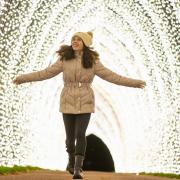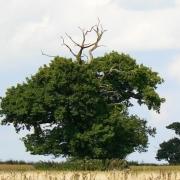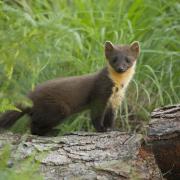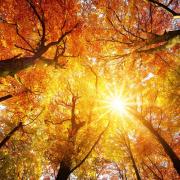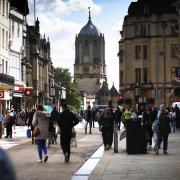Wildflowers are faithful signposts to the seasons, with their presence providing indisputable proof of the time of the year.
Whether it’s steely snowdrops pushing up shoots in late December or the gentle perfume of primroses wafting over the damp February air, we rely on these gifts of nature to give us our bearings.
Come late spring, the sight of woodland bottoms awash with bluebells is as sure sign as any that the approach of summer is gathering pace.
And it’s not only this vision of blue that thrills senses, with their unmistakeable fragrance delighting the nose too.
The familiar image of bluebells often pops up in literature, whether it’s Lisa Kleypas describing ‘the cerulean haze seeping between the trunks of oak and beech and ash’ or Eleanor Farjeon’s description of a ‘blue and magic dream’.
Gerard Manley Hopkins was moved to write of the sight of a bluebell: “I know the beauty of our Lord by it.”
Once known as the “wild hyacinth”, Hyacinthoides non-scripta is abundant in woods, hedges and shady places in May and almost half the global population of this plant is found in the UK, providing a rich source of nectar for a variety of insects, including butterflies.

Native bluebells are often used as an indicator species to identify ancient woodlands – areas of trees that pre-date the 1600s – and flower before canopies grow to cover these areas in shade. The Wildlife and Countryside Act of 1981 states it’s an offence to dig them up.
Indeed, our association with bluebells has led them to earn their place in folklore, with the suggestion that they’re enchanted by fairies.
Fortunately it’s not necessary to go far to find carpets of bluebells in the Cotswolds, but when out walking among them, stick to paths to avoid treading on the flowers, keep dogs on leads and keep an eye on dogs and horses, which have been reported to suffer digestive problems after eating bluebell leaves.
For an unbeatable view of bluebells as far as the eyes can see, the 42 square miles (110 sq km) that makes up the Forest of Dean is a great place to start.
Poor’s Allotment near Tidenham is home to a number of rare flowers and a large population of threatened dormice. The site, which has spectacular views over the River Severn, has recently undergone a series of improvements by Gloucestershire Wildlife Trust to make it more accessible.
Beechenhurst is an area of woodland near Coleford that’s looked after by the Forestry Commission. Along with lovely walks, it offers a family activity trail, a large forest-themed play area and the Go Ape high ropes course, and it’s home to the Forest of Dean Sculpture Trail too.
The Laurie Lee Wildlife Way, created by the Gloucestershire Wildlife Trust, is a wonderful route to follow in May, combining the glorious views known by the famous son of Slad with extracts of his poetry and delightful walks across hillsides and through woodlands. There’s also a great signed route around Lower Woods near Wickwar, one of the largest ancient woodlands in the south west.
Bluebells are especially prevalent in hazel woodlands that would have been ‘coppiced’ on a regular basis in years gone by.
Back then groups of trees, known as ‘coups’, would have been cut back to stumps known as ‘stools’ to encourage them to produce multiple stems rather than a single trunk.
This work was undertaken on a rotational basis, leading to increased light levels reaching the woodland floors every few years and improving the growing conditions for various wildflowers.
Among the woodlands known to have been coppiced for many years are Siccaridge Wood near Sapperton, with records showing the practice having taken place in 1535, although wildlife experts from Gloucestershire Wildlife Trust believe it was going on for longer.
While bluebells are usually associated with woodlands, it’s possible to grow them in gardens too, although over the past century or so this has led to native populations coming under threat from imports of their Spanish cousin Hyacinthoides hispanica.
The two hybridise easily, leading to swathes of bigger and burlier bluebells that out-compete the wild ones.
It’s easy to tell them apart: the flowers of H. non-scripta are a deep blue, fragrant and dainty and the individual florets are arranged on one side of its stem while on H. hispanica they are paler, less perfumed and arranged around the stem.
While it’s not an offence to grow Spanish bluebells, wildlife experts caution over planting them close to woodlands due to the risk of bees mixing their pollen and to seek out native bulbs instead.

Best spots for bluebells in the Cotswolds
Here are our other top picks:
Beechenhurst near Coleford
Betty Daw’s Wood, near Dymock
Bredon Hill – approach from Beckford
Buckholt Woods National Nature Reserve near Cranham
Chosen Hill near Churchdown
Collin Park Wood near Upleadon
Foxholes Nature Reserve, Foscot, near Chipping Norton
Frith Wood – an ancient beech wood on the ridge overlooking Painswick Valley and Slad Valley.
Kiftsgate Court, near Chipping Campden (admission charges apply)
Leckhampton Hill – look for walking trails
Lower Woods, near Wickwar
Lynches Wood, close to Dover’s Hill near Chipping Campden
Midger Wood near Hillesley
Mythe Railway near Tewkesbury
Painswick Rococo Gardens (admission charges apply)
Parish and Old Hills Wood near Chalford, looked after by The Woodland Trust.
Poors Allotment, Tidenham
Randwick Woods near Stroud
Ridley Bottom near Stroat
Siccaridge Wood near Sapperton
Three Groves Wood between Oakridge and France Lynch
Tiddesley Wood near Pershore
Woodchester Park, near Nailsworth








